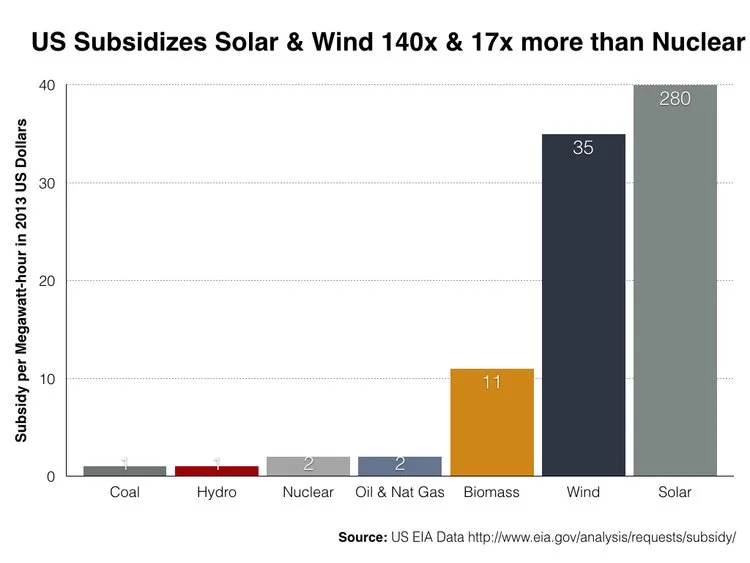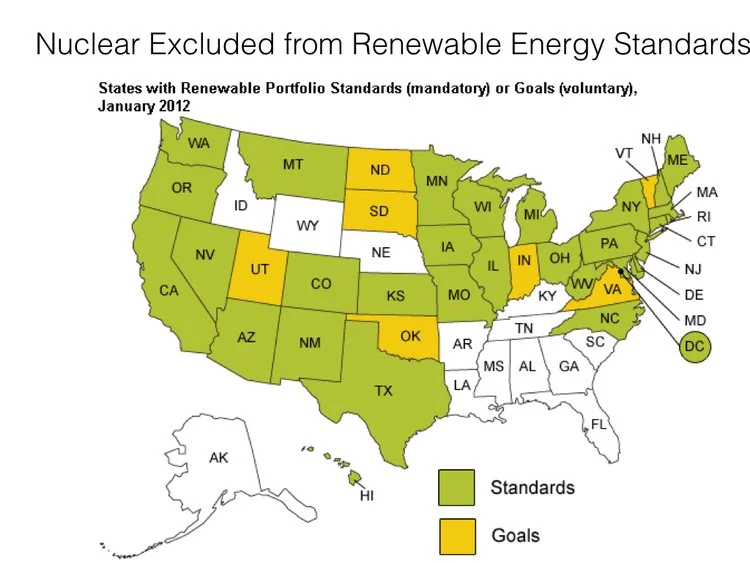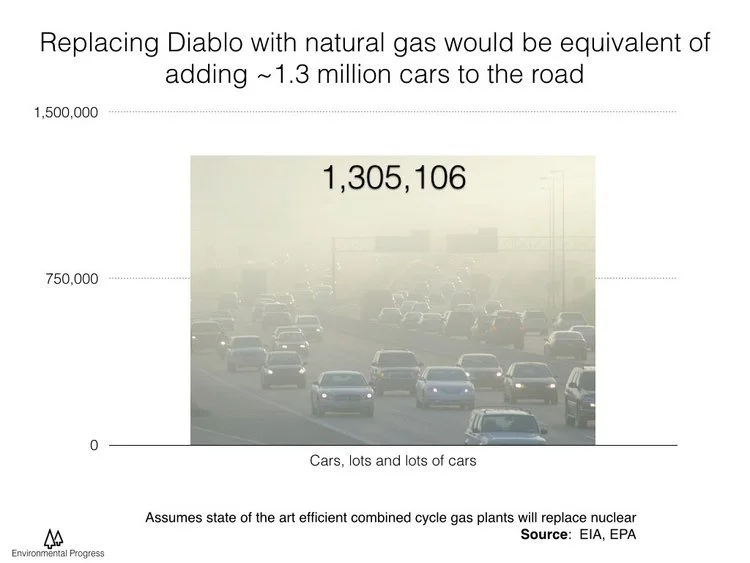CLEAN ENERGY IS ON THE DECLINE — HERE'S WHY, AND WHAT WE CAN DO ABOUT IT
PLUS: WHY ENVIRONMENTALISTS KEEP CHANGING THEIR MIND ON NUCLEAR
May 2, 2016
Originally published in Public Utility Fortnightly [download pdf]
Utilities that own nuclear power plants are in serious financial trouble. While it is tempting to blame low natural gas prices and misplaced post-Fukushima jitters, nuclear’s troubles are rooted in regulatory capture — a capture that finds its genesis in the origins of the U.S. environmental movement. This capture is now threatening to bring this climate-friendly energy source to the brink.
Consider that in the U.S., utilities have either closed or announced premature closures of seven plants in three years. At least eight more are at risk of early closure in the next two years. In 2011, Germany announced it would close all of its nuclear plants. Swedish utility Vattenfall announced late last year that it would be forced to close several reactors prematurely.
Everywhere the underlying reason is the same: anti-nuclear forces, in tandem with rent-seeking economic interests, have captured government policies. On one extreme lies Germany, which decided to speed up the closure of its nuclear plants following Fukushima. In Sweden the government imposed a special tax on nuclear. In the U.S., solar and wind receive 140 and 17 times higher levels of subsidy than nuclear. And states across the nation have enacted Renewable Portfolio Standards, RPS, that mandate rising wind and solar, and that exclude nuclear.
To be sure, nuclear has also been hurt in the U.S. by low natural gas prices. But if nuclear were subsidized at the same levels as solar and wind, or allowed to contribute to state RPS, nuclear would continue to be highly economical. Proof is that wind and solar have boomed over the last five years when natural gas prices have been very low. Furthermore, when wind and solar subsidies are withdrawn, whether in the U.S. or Europe, installation of wind and solar declines dramatically.
Governments discriminate against nuclear energy because it is deeply unpopular. Globally, the opinion research firm Ipsos found that nuclear’s approval rating is just 28 percent – just three percent higher than coal, the least popular fuel – while solar and wind are supported by 85 and 78 percent of the public. And for the first time in twenty years, only a minority of Americans told Gallup they support nuclear as part of the electricity mix – just 44 percent in 2016, compared to 61 percent in 2000.
Why is nuclear so unpopular? There’s no question the 2011 Fukushima meltdowns contributed to nuclear’s problems. But nuclear was on the decline long before then. Nuclear went from 18 per- cent of global electricity in 1996 to 12 percent in 2011. And nuclear declined 10 percent in absolute terms between 2006 and 2014.
Against the hype about solar and wind’s rapid growth, the decline of zero-carbon energy shows that they do not make up for loss of nuclear. Zero-carbon power as a percentage of global electricity declined from 36 to 31 percent between 1993 and 2014.
All of this is bad news for anyone who cares about reducing pollution, whether to slow climate change or simply clean the air.
WHY ENVIRONMENTALISTS BECAME ANTI-NUCLEAR
Few people realize that up until the early-seventies, environmentalists including the Sierra Club itself was pro-nuclear. “Nuclear energy is the only practical alternative that we have to destroying the environment with oil and coal,” said famed nature photographer and Sierra Club Director, Ansel Adams.
Nuclear’s environmental benefits are the same today as they were back then. Nuclear power plants produce zero air or water pollution, aside from those that produce hot, clean water, which has very minor impacts. It uses tiny quantities of natural resources. Solar and wind require three to five times as much steel and concrete as nuclear plants.
Because of its high energy density, uranium’s mining impacts are miniscule compared to coal, oil and natural gas. Few material inputs mean very small amounts of waste outputs. And, as conservationists from California to Germany have learned, trying to replace nuclear with solar and wind requires 100 to 700 times more land.
How then did environmentalists come to view nuclear as bad for the environment?
Starting in the mid-sixties, a handful of Sierra Club activists feared rising migration into California would destroy the state’s scenic character. They decided to attack all sources of cheap, reliable power, not just nuclear, in order to slow economic growth.
“If a doubling of the state’s population in the next 20 years is to be encouraged by providing the power resources for this growth,” wrote David Brower, who was Executive Director of the Sierra Club, “the state’s scenic character will be destroyed. More power plants create more industry, that in turn invites greater population density.”
A Sierra Club activist named Martin Litton, a pilot and nature photographer for Sunset magazine, led the campaign to oppose Diablo Canyon, a nuclear site Pacific Gas and Electric proposed to build on the central Californian coast in 1965. Sierra Club member “Martin Litton hated people,” wrote a historian about the how the environmental movement turned against nuclear. “He favored a drastic reduction in population to halt encroachment on park land.”
But anti-nuclear activists had a problem: their anti-growth message was deeply unpopular with the Californian people. And so they quickly changed their strategy. They worked hard instead to scare the public by preying on their ignorance.
Doris Sloan, an anti-nuclear activist in northern California said, “If you’re trying to get people aroused about what is going on ... you use the most emotional issue you can find.” This included publicizing images of victims of Hiroshima and photos of babies born with birth defects. Millions were convinced a nuclear meltdown was the same as a nuclear bomb.
Not Martin Litton. When asked if he worried about nuclear accidents he replied, “No, I really didn’t care because there are too many people anyway.” Why then all of the fear-mongering? “I think that playing dirty if you have a noble end,” he explained, “is fine.”
But the fear-mongering worked on a young and idealistic Amory Lovins, the renewable energy advocate, who began his career crusading against nuclear weapons. Lovins’ basic framework of transitioning from nuclear to renewables was promoted by David Brower and Friends of the Earth and eventually embraced by Sierra Club, Greenpeace, Natural Resources Defense Council, the Union of Concerned Scientists, the German government, Al Gore, and a whole generation of environmentalists.
Environmental Law & Policy Center takes money from natural gas & renewables companies while lobbying for legislation that would replace zero-carbon nuclear plants with natural gas
Environmental Law & Policy Center takes money from natural gas & renewables companies while lobbying for legislation that would replace zero-carbon nuclear plants with natural gas
The highest priority of the environmental movement was now to phase out nuclear, not fossil fuels. “It is above all the sophisticated use of coal, chiefly at modest scale, that needs development,” Lovins wrote in 1976. Around the same time Sierra Club’s Executive Director, Michael McCloskey, referred to coal as a “bridge fuel” away from nuclear and to renewables.
Nothing much has changed. In flat contradiction of their stated views that climate change represents an imminent cata- strophic threat, anti-nuclear environmentalists from Germany to Illinois to California bless the burning of fossil fuels if it means they can force the closure of a nuclear power plant.
“We don’t need nuclear power,” environmental activist Bill McKibben told an audience at Middlebury in 2014, after a showing of the pro-nuclear documentary “Pandora’s Promise.” The world, he has repeatedly insisted, can be powered entirely on wind, water and solar energies. At the same time, Vermont Senator Bernie Sanders, who McKibben endorsed early in the Democratic presidential nomination process, and national environmental groups were quietly blessing the replacement of Vermont Yankee with natural gas.
Indeed, for the last twenty years environmental leaders have on the one hand, said they want a level playing field and on the other, worked hand in glove with solar and wind companies to win special treatment for renewables. Because solar and wind require fast-ramping back-up when the sun stops shining and wind stops blowing, both progress with natural gas. Various pieces of legislation in California, its famous AB32 climate bill, its recently-passed SB350, and its RPS, all paved the way to replacing nuclear with natural gas.
California epitomizes the vulnerability such a situation creates. Natural gas is today a whopping 61 percent of the state’s electricity and will rise to 70 percent if it closes its last nuclear plant, Diablo Canyon. Pollution spiked in 2013 when California officials, at the pleading of Friends of the Earth and other environmental groups, forced the closure of the San Onofre nuclear power station.
Now, California officials predict two weeks of brown-outs this summer – a reliability crisis caused by taking San Onofre off-line and the natural gas blow-out at Porter Ranch gas storage facility inside Aliso Mountain. An unprecedented 91 thousand tons of methane spilled into the atmosphere. California environmental regulators are embarrassed by the blow-out. But none of them has yet come to admit that it is a logical consequence of the state’s over-reliance on natural gas, itself a consequence of the state’s forty year crusade against nuclear power.
WHY ENVIRONMENTALISTS BECOME PRO-NUCLEAR
Support for a comeback by nuclear power has come from the unlikeliest or perhaps likeliest of sources: environmentalists. Ten years ago one of the founders of the anti-nuclear environmental movement, Stewart Brand, famously reversed his position. Since then he’s been joined by climate scientist James Hansen, British columnist George Monbiot, the former CEO of The Nature Conservancy, the former Executive Director of Greenpeace, the U.K., and many others including myself.
These pro-nuclear environmentalists are part of a tradition that goes back fifty years, to 1966, when Sierra Club Director David Siri wrote:
“Nuclear power is one of the chief long-term hopes for conservation ... Cheap energy in unlimited quantities is one of the chief factors in allowing a large rapidly growing population to preserve wildlands, open space, and lands of high scenic value ... With energy we can afford the luxury of setting aside lands from productive uses.”
Fifty years of empirical research show that Siri was right and the anti-growth anti-people extremists who started the anti- nuclear movement were wrong. More energy is good for people, and it’s good for nature.
Energy allows cities and agricultural intensification, which frees the countryside for return of forests and wildlife. Moving to nuclear frees us from air pollution, including carbon emissions.
This pro-nuclear movement, independent of any energy interest, has the potential to do what the electric utilities cannot do: protect and expand nuclear power. Over the last three months, Hansen and dozens of the world’s top scientists and leading conservationists have issued a series of public letters on the need for fair treatment of nuclear power, while a grassroots movement has swelled around the world. Pro-nuclear environmentalists – most of them volunteers like Sierra Club activists before them – are working in New York, California, Illinois, Minnesota, Florida, Ohio, as well as in Britain, Germany, Sweden, Finland.
Utilities serve the public and must thus be sensitive to the will of the people. At the same time, they need not merely watch from the sidelines. Caught off-guard by the impact of clean energy policies that discriminate against nuclear, utilities have mostly reacted on the defensive, seeking bail-outs for nuclear plants, and going to court. Utilities with nuclear plants, and the companies that make them, are currently in disarray, and divided when it comes to important pieces of legislation.
The situation can change, though it may take a decade or longer. Utilities that own nuclear plants must do a better job making the environmental case for their plants and, at the same time, seek policies that treat all sources of clean energy fairly.
Nothing ever comes easy when it comes to policy reform. But the urgency provided by the loss of nuclear plants, combined with a focus on energy fairness as the guiding principle of policy reform, would be enough to stop and eventually reverse nuclear’s decline.
Michael Shellenberger is President of Environmental Progress, a new environmental organization advocating ethical and practical solutions for nature and prosperity for all. He is coauthor of “An Ecomodernist Manifesto,” “Break Through,” and “The Death of Environmentalism.” He lives in Berkeley, California












